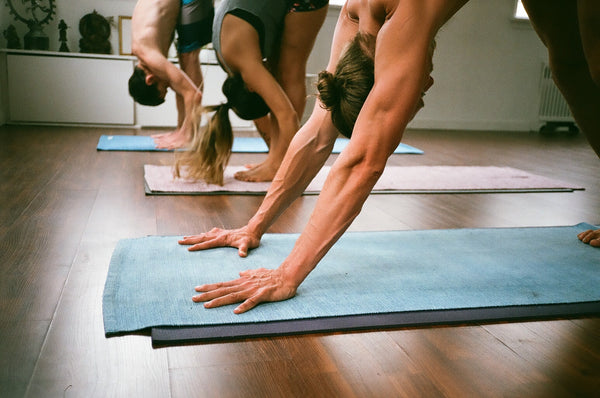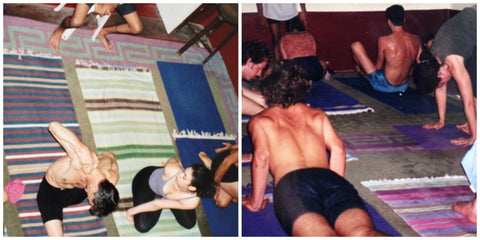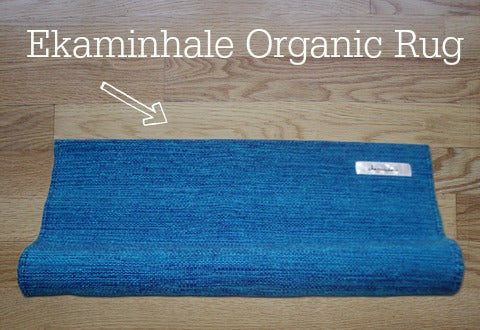Why Extra Grip Equals Extra Weak

Would you ride a mountain bike with training wheels? Seems kind of ridiculous right?
Then why are you using a sticky mat? Or anything with "extra grip"?
Just like training wheels the extra grip could be necessary in the beginning but at some point you will be strong enough to move to the next level.
In this post I will explain how I adjusted the difficulty of the surface level I practice on so I could build stronger legs, feet and back and how it made a massive difference in my practice.
This is part of the Strong Foundations Emails Series
*Please note this is not to be taken as medical advice or the advice of your teacher or doctor. This is personal experience only.
"Everybody buy a cotton rug!"
Our teacher in India poked his head out the shala entrance doors and said this one day while I was waiting to get into practice.
I said to the students next to me. “I’ll sell you one!”.
He was saying it because the new floors in the shala were getting soaked with sweat and getting slippery so people needed rugs to soak it up.
I looked in to see how many people were using rugs and it was surprising to see a large amount were not.
It’s the modern way of practicing yoga. Natural materials have been traded for synthetic.
In the same way that the students at KPJAYI in the 70's weren't on their cell phones before practice they also weren't chilling out on sticky mats.

Does it matter? In my experience it does.
One of the things that happens when you add in some type of technology is that something natural gets replaced.
Certain situations it’s necessary for example in the case of where there is a medical condition and a person can’t sweat. (which is why the sticky mat was invented by the way)
Or say you have an injury and the body needs support. But are you using the the prop for those reasons or just to make the asanas easier?
It’s completely up to you and your teacher if you decide to use support but if that isn’t your intention and you want to build strength by incrementally challenging yourself then using a prop isn’t going to get you there.
This is where I found myself when looking for ways to heal my back pain.
I wanted to get strong again. I started to look for places to build strength.
One of them was by using a rug right from the first Sun Salutation. I first learned about his this from Mark Darby and Nancy Gilgoff who both say to use a rug from the beginning.
"According to Nancy, you shouldn’t be taking time out in the middle of your practice to roll it out, or squirt it with water or anything else that draws away your focus and your breath. And being able to stay balanced on the rug is the point, and will help you build strength." - Confluence Countdown Blog
When I was visiting the Organic Mysore Rug supplier I asked him - "what is the number one complaint you get from people about the rugs?"
He said - "that it's too hard"
I hear that same complaint time and time again.
"It’s too hard. It’s too slippery." Yes you are right. It is hard. And as Nancy said. “That’s the point”.
But like anything it needs to be just hard enough. Not so hard you are going to hurt yourself but also not so easy that nothing is happening. With the grippy practice surfaces a lot of times it makes standing postures too easy. You don’t need to use the inside of your legs to keep your feet from sliding apart
With the assistance of a sticky mat the legs and feet can all just chill out. Sort of like sitting on a chair instead of a full squat.
We get this idea that the standing postures are more of a warm up. No big deal. We’ll just get them done and the get into the fun stuff like lifting up and jumping back etc.
The standing postures get glossed over and ironically this is when most people will put down their rugs.
Here's a little insight that will change your practice forever.
The standing postures aren’t the beginning of the series. The are the foundation to the series
Yes the standing postures are at the beginning but to think if them as easy or unimportant is a big mistake.
Just like a building they are what holds everything else up. Can you imagine what would happen if someone building an skyscraper didn't create a strong foundation? That thing no matter how good it looks from the outside is going to eventually fall over.
There is No Pulling In Ashtanga (or is there?)
I still can't get over this one.
You often hear the teacher say in class when people are in downward facing dog - "push with your hands!". I guess they want you to "lengthen the hamstrings!". Besides the fact that pushing into your hamstrings won't do much I suggest you try the opposite.
If you try and push into your hands on a rug in the first Sun Salutation it doesn't work so well. It takes some time for the sweat to create dampness and grip. The rug will feel a bit slippery so instead you actually have to pull with your hands.
The subtle action of pulling sets off a cascade of events in your body that strengthens & stabilizes your back. I'm hesitant to say which muscles do what since I don't believe we have the capacity to actually know because of the complexity of our bodies. It's a whole other topic so for now let's just say pulling is good for the back.
What I find is a better action is thinking of pulling with armpits. If you use a rug then you don't really need to think about it. The challenge just makes you do that action.
The other point is that this action puts the emphasis on building strength by making a nice shape for the breath to be "free". Now that will lengthen the hamstrings.
Choose The Right Degree of Work
There is a video of David Robson talking about jumping back where he says - “you need to find your hardest version”. It's the same for the standing postures.
How hard it is for you is going to be affected by:
1. The surface you do your practice on.
2. How much you sweat
3. How strong you are on that day
These conditions change. For example when I’m practicing in Mysore the room is hot. I start sweating even before I go into the shala. My rug has more grip in these conditions
In Jasper Canada where the air is dry, it's colder and I practice alone often I don’t sweat till much later in the practice. I find my rug can be twice as slippery compared to India.
Or when I first take it out of the wash. I always notice that on that first day after the wash it’s a little bit more slippery. Doesn’t matter. I’m aware of it and if it’s too difficult for my strength at that time then I do what is necessary so I don't work so hard I hurt myself
The problem doesn’t lie in it being too hard. It's when it's too easy.
There are ways to decrease the difficulty which I'll explain next.
Developing strength in the beginning of your practicr so it’s available to you later in the series when things get more difficult is essential to avoiding injury.
If you bypass the work in standing then you might have a fancy building for awhile to post some pics on Instagram but eventually it will topple over. Speaking from experience here.
Adjusting the Degree of Difficulty of Your Mysore Rug
"Slow growing is good growing - Guruji"
We're always about all or nothing in the west and that's why we get hurt. You don't learn calculus without first learning how to count so start where you are and work slowly.
Let's look at some of the way you can adjust the degree of strength needed in standing postures by the surface you practice on:
Level 1 - Use a sticky mat then put the rug down after standing. Your feet won’t slide out but you will have a hard time moving them around and pushing through the toes etc in the transitions. Still this may be necessary in the beginning if your legs and feet are too weak. It's ok it's not a race. Build slowly and honestly.
Level 2 - Start with the rug but sprinkle or spray some water where the hands and feet go. This substitutes for sweat and you will find it really grippy. Then when you get to Prasarita Padottanasana (Wide Legged Forward Bend) just flip the rug up and put your feet on the sticky mat. This is only Level 2 remember.
Level 3 - Start with the rug. Spray with water as needed for extra grip but see if you can go without the water. If you are a sweaty person in a hot environment then in not time the rug will be wet from sweat. If you aren’t then you might need to spray it. You decide. Find your hardest version. If you find that when you get to Prasarita Padottanasana its too hard spray it down.
Level 4 - Start with the rug. Ditch the spray bottle. This is the hardest version and If you don’t sweat much then it will be harder. It will get easier and easier over time and before you know it you will feel a foundation like you have never had before.
These are some of the ways I’ve used to adjust my practice surface to find the level that’s right for me given my location, energy etc. I still make a conscious effort to do my hardest version.
Modern western living brings us new challenges for those wanting to practice Ashtanga yoga and yoga asana in general.
We come to these Eastern practices with Western minds and Western bodies which needs to be addressed in order to avoid injury and to practice in way that will nourish you and not destroy you.
I sell the best Mysore Yoga Rugs you can find. Click below to see


